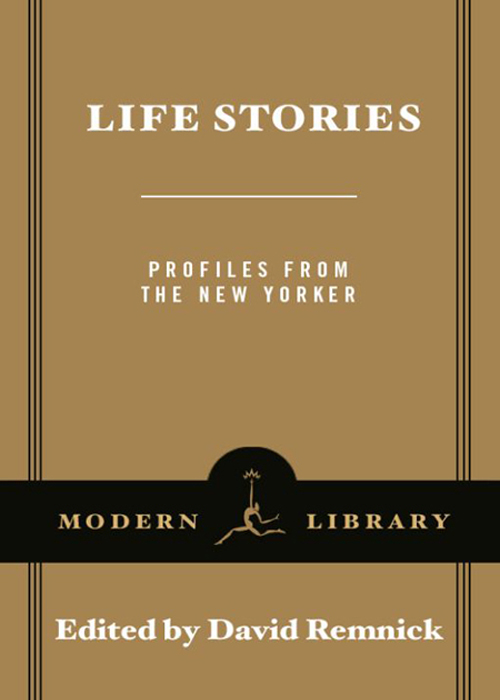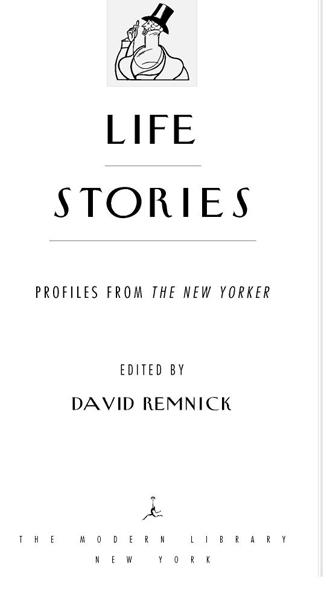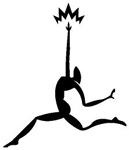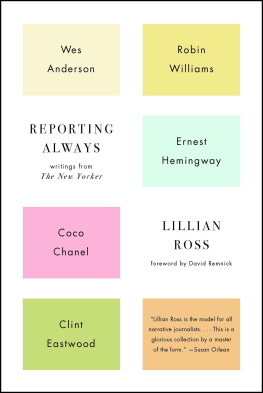

Table of Contents
To Eleanor Gould Packard,
guardian of the sentence
ACKNOWLEDGMENTS
Dozens of New Yorker stafferseditors, writers, assistants, fact checkersgave me lists of their favorite Profiles. I am very grateful for the suggestions. Pamela Maffei McCarthy and Eric Rayman at The New Yorker made the happy arrangement with Daniel Menaker and Ann Godoff at Random House for this volume and for Wonderful Town, a companion collection of short fiction set in New York City. Susan Choi, Dorothy Wickenden, Henry Finder, and Roger Angell worked especially hard in sorting through these Profiles, and Brenda Phipps, Beth Johnson, Chris Shay, and the magazines library staff were also of great help to me and to this project.

INTRODUCTION
DAVID REMNICK
It used to be said around the New Yorker offices that our founding editor, Harold Ross, invented the Profile. But if a Profile is a biographical piecea concise rendering of a life through anecdote, incident, interview, and description (or some ineffable combination thereof)well, then, its a little presumptuous to stick Ross at the front of the queue, ahead of Plutarch, Defoe, Aubrey, Strachey, or even The Saturday Evening Post. And yet in 1925, when Ross launched the magazine he liked to call his comic weekly, he wanted something different something sidelong and ironical, a form that prized intimacy and wit over biographical completeness or, God forbid, unabashed hero worship. Ross told his writers and editors that, above all, he wanted to get away from what he was reading in other magazinesall the Horatio Alger stuff.
James Kevin McGuinness, a staffer in the earliest days of the magazine, suggested the rubric Profiles to Ross. By the time the magazine got around to copyrighting the term, it had entered the language of American journalism. Most of the initial Profiles in the magazine were fairly cursory and bland (and not worth anthologizing). The first was a sketch of the Metropolitan Operas impresario Giulio Gatti-Casazza; it ran just over one page and showed scant evidence of even the most rudimentary reporting. It wasnt terribly funny, either. By 1927, however, the reporting was getting stronger and the writing more irreverent. John K. Winklers Profile of William Randolph Hearst, a five-part piece, was both uproarious and well researched, and Janet Flanner had begun perfecting a shorter form, with a Profile of Edith Wharton.
The most influential of the early Profiles was Alva Johnstons delightful dissection, in 1932, of a phony Russian prince named Michael Dmitry Obolensky Romanoff. The princes real name was Harry F. Gerguson, late of Illinois. (Like Joseph Mitchells great subject, Joe Gould, Gerguson was an irresistible fake. He was so irresistible, in fact, that Ross eventually befriended him and sent him off to Los Angeles, where he could mooch off Dave Chasen, the restaurateur; eventually, Obolensky mooched off enough of Chasens customers to open his own place.) While the mainstays of Rosss New Yorker, E. B. White and James Thurber, did the most to develop the magazines urbane tone and sensibility, Johnston, who had won a Pulitzer Prize as a reporter at The New York Times in 1923 and later moved to the Herald Tribune, gave the Profile form real literary and journalistic weight. Johnston was the first to combine a natural wit and sense of storytelling with the legwork of a first-class newspaperman. His Profiles, especially those of Obolensky and the Florida architect Addison Mizner, influenced generations of New Yorker writers and Profile masters, from A. J. Liebling to John McPhee to Mark Singer. His obituary in the magazine read, in part, When The New Yorker in its earliest days was trying to establish the Profile as a new journalistic form, it was Alva Johnston more than anyone else who set the pace, clarified the idea, and produced the pieces. He gathered and assembled facts in such a way as to give a fresh, candid, gay, and occasionally satirical picture of an individual.
Ross was a man of enormous social energy and mischief, and he was not reluctant to use pieces in The New Yorker as a means of settling feuds and even starting them. St. Clair McKelways Profile of Walter Winchell enumerated hundreds of errors and bogus items in Winchells gossip column; the piece was so thorough a trouncing that it provoked Winchell to report in the Mirror that Ross wore no underwear. Evidently, Winchell had erred again; Ross mailed him the very pair of undershorts he was wearing when he read the offending column. Winchell, for his part, demanded that the owner of the Stork Club ban Ross from his tables.
Wolcott Gibbss skewering of Henry Luce in 1936 heightened the rivalry between The New Yorker and the Time-Life empire, a rivalry that had started with a long, nasty, and well-informed piece on Ross and The New Yorker in Fortune by one of Rosss earliest colleagues, Ralph Ingersoll. Gibbss Profile, which enjoyed Luces cooperation, made a buffoon of its subject and, even more effectively, undermined Timespeak, the queerly stentorian, neologism-studded artificial language of his magazines. (In Gibbss devastating summary, Backward ran sentences until reeled the mind.) Leaning heavily on the reporting of his colleague John Bainbridge, Gibbs subjected Luce to a reportorial strip search, detailing his income, the dcor of his colossal apartment, his odd habits in the office, his taste for pompous middlebrow journalism, and his megalomania. The Profile ended with a stunning flourish: Certainly to be taken with seriousness is Luce at thirty-eight, his fellowman already informed up to his ears, his future plans impossible to contemplate. Where it all will end, knows God!
When Luce was shown the galleys he was furious and demanded a meeting with Ross. Theres not a single kind word about me in the whole Profile, he complained at the late-night summit.
Thats what you get for being a baby tycoon, Ross replied, showing his command of Timespeak.
Goddamit, Ross, this whole goddam piece is ma... ma... malicious, and you know it!
Ross hesitated. Finally, he said, Youve put your finger on it, Luce. I believe in malice.
The New Yorker Profile has expanded in many ways since Rosss time. What had been conceived of as a form to describe Manhattan personalities now travels widely in the world and all along the emotional and occupational registers. There are Profiles of malice (Gibbs on Luce) and Profiles of praise (Joan Acocella on Mikhail Baryshnikov). There are Profiles about identity (Gates on Broyard) and Profiles about the strangeness of American fame (Tynan on Carson). One quality that runs through nearly all the best Profilesthe Profiles represented here and the many, many more for which there was, finally, no room this timeis a sense of obsession. So many of these pieces are about people who reveal an obsession with one corner of human experience or another. Richard Prestons Chudnovsky brothers are obsessed with the number pi and finding the pattern in randomness; Calvin Trillins Edna Buchanan is an obsessive crime reporter in Miami who visits the scenes of disaster four, five times a day; Calvin Tomkinss Philippe Petit has walked from one World Trade Center tower to the other on a tightrope and now wants to walk across the Grand Canyon; Mark Singers Ricky Jay is obsessed with magic and the history of magic. In every great Profile, too, the writer is equally obsessed. Its often the case that a writer will take months, even years, to get to know a subject and bring him or her to life in prose.
Next page





